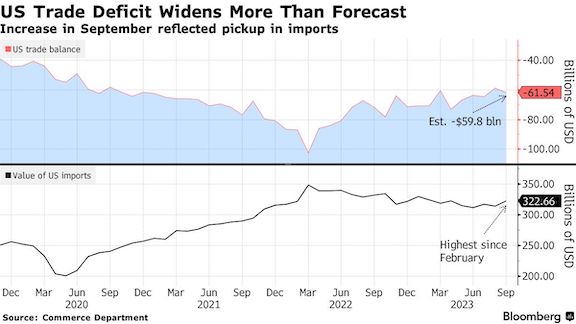The US trade deficit widened by more than expected in September, reflecting the resilience of American demand for foreign goods.
The shortfall in goods and services trade expanded 4.9% from the prior month to $61.5 billion, Commerce Department data showed Tuesday. The median estimate in a Bloomberg survey of economists had called for a $59.8 billion gap.
With the help of solid hiring and low unemployment, American demand for foreign-made goods like cell phones and cars remains firm. That said, there are a growing number of headwinds at home and abroad in the final three months of the year.

Economists anticipate consumer spending to slow markedly from last quarter’s breakneck pace as the labor market begins to cool. The October jobs report released last week showed notable signs of weakness, while tepid economic activity overseas — including growing recession risk in nations like Germany and the UK — may weigh on foreign demand for American products.
The increase in imports reflected more inbound shipments of consumer goods as well as capital goods like computer parts. Exports of petroleum and agricultural products also rose.
Last quarter, net exports subtracted from gross domestic product for the first time since early 2022, reflecting a pickup in imports in the period.
“Based on our early estimates, we expect a small contribution from net exports in Q4,” Rubeela Farooqi, chief US economist at High Frequency Economics, said in a note. “The outlook for trade flows going forward is unclear, and will be depend on the trajectory for demand and growth, domestically and abroad.”
On an inflation-adjusted basis, the merchandise trade deficit widened to $86.5 billion.
Digging Deeper
- Travel exports — or spending by visitors to the US — rose to the highest since the end of 2019
- Travel imports — a measure of Americans traveling abroad — climbed to just shy of a record high
- The US merchandise-trade deficit with China widened slightly. The gap has stuck in a tight range for much of the past year
- The goods shortfall with Mexico narrowed to the tightest since March









